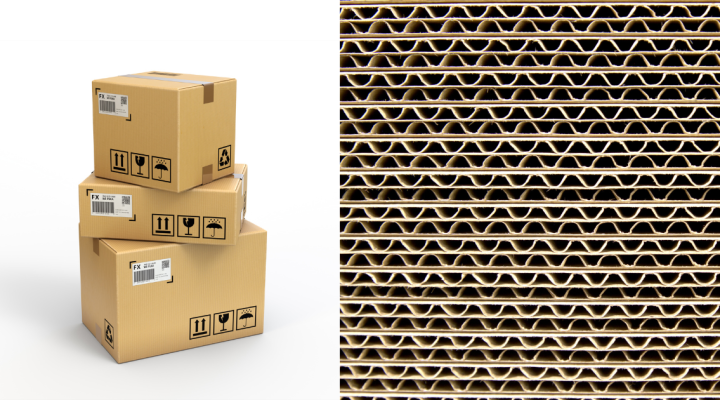
In the world of industrial printing, one material reigns supreme for its versatility, durability, and widespread use – corrugated cardboard. This humble material serves as the backbone for packaging solutions across numerous industries, offering unparalleled protection for goods in transit while providing ample surface area for branding and displaying important information. In this guide, we'll delve into the intricacies of printing on corrugated cardboard, exploring its properties, applications, and the optimal technology for coding and labelling.
Corrugated cardboard is a layered material comprising a fluted corrugated medium sandwiched between two flat linerboards. This construction imbues it with remarkable strength and resilience, making it ideal for packaging fragile or heavy items. The fluted layer provides cushioning and rigidity, while the linerboards offer a smooth surface for printing high-quality graphics and text.
The popularity of corrugated cardboard stems from its unparalleled combination of affordability, versatility, and sustainability. It is lightweight yet sturdy, making it cost-effective to transport while ensuring adequate protection for goods. Additionally, corrugated cardboard is highly customisable, allowing for intricate designs and branding opportunities. Not only that, but it is also recyclable and biodegradable, aligning with the growing consumer demand for eco-friendly packaging solutions.
Corrugated cardboard finds extensive use across many industries, including:
Food and Beverage: Packaging for perishable goods, beverages, and snacks
E-commerce and Retail: Shipping boxes, product displays, and point-of-sale materials
Manufacturing: Protective packaging for electronics, automotive parts, and appliances
Logistics and Distribution: Pallet boxes, shipping containers, and storage solutions
Healthcare and Pharmaceuticals: Packaging for medical supplies, devices, and pharmaceutical products
The versatility of corrugated cardboard makes it indispensable in virtually every sector that requires packaging solutions.
When it comes to coding and labelling on corrugated cardboard, businesses have several options to consider, each with its own advantages and applications:
Continuous Inkjet (CIJ) Printers: CIJ printers are renowned for their versatility and high-speed operation. They utilise a continuous stream of ink droplets to create marks on various substrates, including corrugated cardboard. CIJ printers excel in printing alphanumeric codes, dates, batch numbers, and logos with exceptional clarity and durability. They are ideal for high-volume production environments where speed and reliability are paramount. As a channel partner for Markem-Imaje we can supply you with brand new 9000 Series coders.
Thermal Transfer Printers: Thermal transfer printers use heat to transfer ink from a ribbon onto the surface of corrugated cardboard. This technology offers precise control over printing parameters, resulting in sharp, high-resolution marks. Thermal transfer printers are well-suited for applications requiring barcodes, QR codes, and variable data printing. They are commonly used in industries where precise product identification and traceability are essential, such as pharmaceuticals and electronics. Brand new technology options include the Markem SmartDate Series.
Print and Apply Labelling Systems: Print and apply labelling systems combine printing and labelling functions into a single automated process. These systems print labels with variable information, such as barcodes and serial numbers, and apply them directly onto corrugated cardboard packaging. Print and apply systems offer flexibility in label design and placement, making them ideal for on-demand labelling and customisation. They are frequently used in logistics, distribution, and manufacturing environments to streamline packaging operations and improve traceability. As us about the 2200 Series and 2200 Series Flex SE from Markem-Imaje.
Laser Coding: Laser marking systems have a focused laser beam to etch or engrave codes and markings onto the surface of corrugated cardboard. Laser marking offers exceptional precision and permanence, producing high-contrast marks that withstand abrasion, moisture, and other environmental factors. Laser marking is well-suited for applications requiring permanent coding, such as serial numbers, logos, and regulatory markings. It is commonly used in industries where durability and tamper resistance are critical. If you need a solution like this speak to the team about the Markem-Imaje SmartLase C150 and SmartLase C350 that can code more than 100,000 products per hour.
Industrial printing technologies support a wide range of codes and markings, including but not limited to:
Barcodes and QR Codes: Facilitate inventory management, tracking, and traceability
Date and Batch Codes: Essential for product traceability and compliance with regulatory standards
Logos and Graphics: Enhance brand visibility and aesthetics on packaging materials
The flexibility of these technologies allows businesses to incorporate various codes and markings to meet their specific requirements.
Investing in high-quality coding and labelling technology for corrugated cardboard offers numerous benefits, including:
Enhanced Legibility: High-resolution printing ensures that codes and labels remain legible throughout the supply chain, reducing the risk of errors and misinterpretation.
Compliance Assurance: Reliable printing technology enables manufacturers to meet regulatory requirements and industry standards, avoiding costly penalties and recalls.
Brand Integrity: Crisp, professional-looking marks enhance brand perception and consumer trust, reinforcing brand integrity and recognition.
Operational Efficiency: Efficient printing systems minimise downtime and maintenance requirements, maximising productivity and cost-effectiveness.
Mastering industrial printing on corrugated cardboard requires a comprehensive understanding of the material's properties, applications, and the optimal technology for coding and labelling. By leveraging high-quality printing solutions, manufacturers can elevate their packaging capabilities, ensuring product integrity, compliance, and brand excellence.
Corrugated cardboard stands as a cornerstone of modern packaging, offering unmatched versatility, sustainability, and cost-effectiveness. Through strategic investment in quality printing technology, manufacturers can unlock the full potential of corrugated cardboard, allowing it to be used for branding, displaying information, and regulatory compliance.
If you're new to printing on corrugated cardboard or looking to upgrade your existing technology then Contact us today and we’d be more than happy to discuss your requirements.